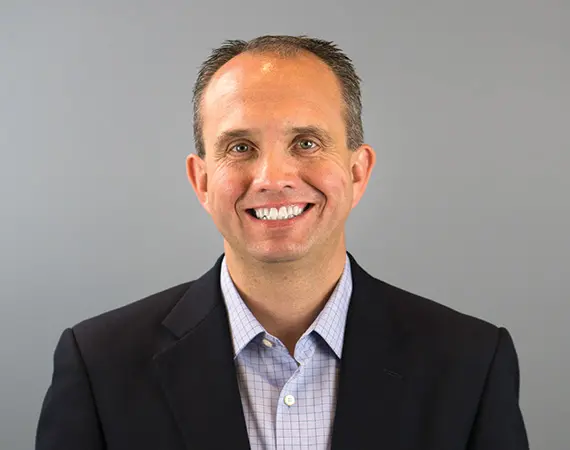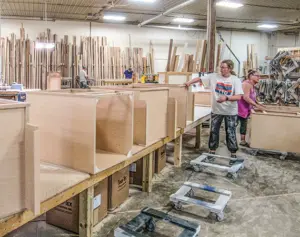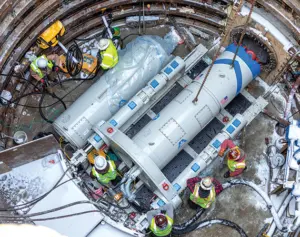If you’re a small- to medium-sized manufacturer in southwestern Minnesota, you might want to get to know Scott Marquardt.
“If your business has a capital need, call us,” says Marquardt, the relatively new president of the Southwest Initiative Foundation (SWIF). “I don’t want to put the burden on the entrepreneur to figure out if we’re a fit or not.”
Marquardt is the new — and optimistic — president, having been installed in February. He’s new to the job, but not new to SWIF. A resident of Montevideo, he has led SWIF’s economic development work for the past 15 years, most recently as senior vice president. Marquardt succeeds Diana Anderson, who oversaw SWIF as president and CEO for 21 years. After earning bachelor’s and master’s degrees from the University of South Dakota, Marquardt spent eight years as economic development director for the city of Montevideo. From there he moved on to SWIF.
Marquardt says he hopes to continue a tradition of building trust between SWIF as a lending and economic development organization and the community.
“We are a relationship-based organization — relationships with our borrowers, with our businesses, with our fellow lenders and partners,” he says. “It’s important to reach new people who we can invest in, but also be by their side during the ups and the downs. Relationships are critical to everything that we do.”
If you’re unfamiliar with the initiative foundations around the state, it’s quite simple: They loan money. And manufacturers are one of the biggest beneficiaries of such loans. In SWIF’s more than 40 years of existence, nearly 35% of all loans have gone to small- and medium-sized manufacturers.
Marquardt hopes to continue that trend. Loans to manufacturers have the highest limit; such loans, which typically cover the high equipment costs manufacturers face, can be up to $300,000. He also concedes that a SWIF loan may not be best. It depends on the manufacturer’s needs, and that’s why Marquardt urges anyone interested to call him.
Marquardt cites a study conducted 10 years ago by SWIF and the Southern Minnesota Initiative Foundation (which together cover all of southern Minnesota) that found manufacturing comprises 20% of all jobs in their areas combined.
“That is statistically significant and very different than if you took a similar region in any other part of the country,” he says. “Because of that report, our loan limit for manufacturing is double what it is for other sectors.”
Marquardt says SWIF’s loans aren’t necessarily the most or least expensive, but somewhere in the middle. An interest rate for an equipment loan drawn up today will probably be 5-6%. They don’t grant credit lines and all loans are fixed-term.
Marquardt points to a few case studies to illustrate the diversity of clients they’ve worked with.
Millennials Mark Eiden and Tobias Flood founded Metal Trade Solutions LLC, a metalworking job shop in Winsted. SWIF’s Microenterprise Loan Program got them started with a loan to purchase a CNC plasma cutter. Five years later, the business is thriving.
Keith and Ashley Fredrickson opened K&A Sheetmetal Fabrication in Hutchinson with help from SWIF’s Microenterprise Loan Program. The new business produces HVAC duct, architectural flashing and custom enclosures as well as providing general sheet metal fabrication. A SWIF loan provided capital to purchase the equipment.
Midwest Fire Equipment & Repair Company in Luverne manufactures fire tankers and pumpers. Last year, SWIF helped Sarah and Dean Atchison purchase the business. This involved collaborative financing assistance from SWIF’s Business Finance Program, The First National Bank in Sioux Falls, Prairieland EDC, and the Southwest Regional Development Commission.
Assessing the state of manufacturing, Marquardt says the diversity of industry types is healthy for the region.
“We have a very diverse manufacturing base with a significant number of sectors, from agriculture to electronics to everything in between,” he says. “We’ve engaged with a lot of food manufacturing, construction, manufacturing of construction materials, a geothermal heat pump company, to name a few. That’s very different than if we were dominated by one sector.”
A big part of Marquardt’s job is to make communities attractive to businesses.
This means advocating for affordable housing and childcare. Both represent significant costs to families, and both are increasingly scarce. Such a priority, Marquardt says, helps all manufacturers, not just small- and medium-sized ones.
“A major focus for me has been working with communities on childcare projects. We think that impacts
manufacturing,” he says. “We also support housing studies in communities, which are obviously informed by the entire manufacturing sector.”
“We believe the manufacturing sector in southwest Minnesota brings hope for the future of our region,” he adds. “And a lot of that investment is in manufacturing right now.”
Return to the Fall 2023 issue of Enterprise Minnesota® magazine.


